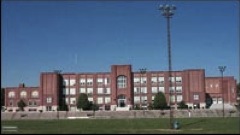What about the students outside St. Louis?
10/29/08 12:52 Categories: Assessment

Photo by Hira3
Local school districts like to tout their rankings in MAP scores as a way to demonstrate quality. “We’re #1 in St. Louis in this particular grade in a math scores at this elementary school. Yay us!” While districts do have some reasons to compare themselves to other districts within the metropolitan area, they do need to realize the limitations.
After listening to a district list its MAP score rankings within St. Louis at a parent meeting, a friend complained to me about the “provincial” thinking. “These kids compete for college with students across the country, not just from St. Louis.” Friends of mine who are from other cities don’t understand our emphasis on competing against only local schools.
I’ll start by trying to focus less on St. Louis-only comparisons and incude more state comparisons when discussing MAP scores. I’ll also try to compare across state lines and international when possible. If I want districts to broaden their outlook, I should start by doing so here.
Reporter asks Obama re NCLB
10/18/08 19:02 Categories: NCLB
At a rally of 100,000 here in St. Louis, Leisa Zigman of KSDK asks Barack Obama about the future of NCLB especially considering that no St. Louis County district met AYP goals even though many of them are “overperforming.” (Overperforming?) He said we need to change the way we assess schools so that we encourage accountability but in a way that is possible for schools to meet.
Science: What gets tested gets taught
10/13/08 09:45 Categories: Science | Assessment

Photo by Adam Baker
Since the MAP is including science now, schools are increasing their focus on teaching science although I’m not sure they have enough.
All of this comes as economic and education experts worry about U.S. global competitiveness.
“We should be embarking immediately on an all-hands-on-deck, no-holds-barred, no budget-too-large crash program for science and engineering education.” (Thomas L. Friedman in The World is Flat 3.0)
Missouri needs to increase its state requirements for graduation. All students need to take biology, chemistry and physics (not necessarily in that order). Students graduating in 2010 are required to take three years (same as math and history), which is an increase from the currently required two years. I think all students should take four years of all four core subjects. Most schools don’t require physics, but the concepts are essential in science and can be taught to all. (See previous post on teaching physics first.)
For example, Hazelwood currently requires students to take Physical Systems and Chemical Systems, each a semester course. Then students are required to take biology for a year. This includes students with a College Prep designation on their diploma. With the requirement increase, students are then required to add another year of science of their choice. Only one semester of chemistry? They offer a full year of chemistry but don’t require it. This is not enough science for people competing with other countries for jobs and deciding on the direction of science via elections.
Francis Howell currently requires a year of physical science and a year of biology. Chemistry and physics are optional.
Elementary schools need to increase the emphasis on science and integrate science with math and reading.
MRH, which has a helpful curriculum online, does not include science K-5. Is it not important enough?
Rockwood does include a grade-by-grade detailed list of its science curriculum starting at the K level. It also puts on a Science Expo at the beginning of the year to stir up excitement and let the students and parents know of science resources available in St. Louis.
Mehlville doesn’t include the detail that Rockwood does, but it gives an easy to decipher overview of the content covered in each grade, the name of the textbook used (!) and suggested resources and activities for families. As an educator I like the Rockwood detail, but the Mehlville overview is definitely more readable. I would like districts to include both.
I looked at the 2008 MAP 5th grade science scores comparing median MAP scale scores. None of the top 10 in the state were in the St. Louis metropolitan area, but none of them had more than 27 students taking the test, so I narrowed my list to districts in the metropolitan area, including charter schools. The top school districts were not surprising, but I was intrigued by some of the districts on the list such as Washington, Windsor and Fox. Parkway was 16th. Union and Festus were 11 and 12.
| DISTNAME | MEDIAN_SCALE_SCORE |
| ROCKWOOD R-VI | 684 |
| LADUE | 682 |
| KIRKWOOD R-VII | 680 |
| CLAYTON | 680 |
| LINDBERGH R-VIII | 677 |
| BRENTWOOD | 676 |
| WEBSTER GROVES | 676 |
| WINDSOR C-1 | 674 |
| FOX C-6 | 674 |
| WASHINGTON | 673 |
I then searched to see if the same districts had the highest number of students scoring at the advanced level.
| DISTNAME | ADVANCED_PCT |
| ROCKWOOD R-VI | 39.6 |
| LADUE | 36.2 |
| CLAYTON | 30.2 |
| KIRKWOOD R-VII | 28.9 |
| WEBSTER GROVES | 28.5 |
| LINDBERGH R-VIII | 25.4 |
| ORCHARD FARM R-V | 22.9 |
| WASHINGTON | 22.3 |
| FOX C-6 | 22.2 |
| JEFFERSON CO. R-VII | 20.2 |
Most of the districts were the same with Orchard Farm joining the list and Windsor falling to 11. Parkway moved up to 12.
Sorting by median Terra Nova scores shuffled the districts a bit bringing New Haven (Franklin Co. R-II) into the top.
| DISTNAME | MEDIAN_TERRANOVA |
| ROCKWOOD R-VI | 82.0 |
| CLAYTON | 81.0 |
| BRENTWOOD | 80.0 |
| KIRKWOOD R-VII | 79.0 |
| LADUE | 77.0 |
| FRANKLIN CO. R-II | 77.0 |
| WEBSTER GROVES | 76.0 |
| UNION R-XI | 74.0 |
| FOX C-6 | 73.5 |
| LINDBERGH R-VIII | 73.0 |
Rockwood comes out on top in every configuration. Whether it is the Science Expo, detailed expectations or another reason altogether, the elementary schools there come ahead.
I’ll be interested to watch whether this new focus on science raises everyone’s scores.
Put that curriculum on the website!

Rockwood: detailed information on curriculum by content area, info on curriculum development, easy-to-use website
Mehlville: pdf of each grade and high school
MRH: pdf of each school level (elementary, middle, high) and content area, assessment report, easy-to-use website
Clayton: info on curriculum development including names of curriculum coordinators but not information on content level or grade level objectives
Ladue: info limited to elementary math under the district curriculum section
Ferguson-Florissant: no information on district site that I could find via browsing or by search, no info in at least two elementary schools (Airport Elementary, Bermuda Elementary)
SLPS: no information that I could find via browsing, no search available; no info in at least three elementary schools (Adams, Ashland and Cote Brilliante)
Since curriculum drives education, I applaud Rockwood and MRH for having comprehensive, easy-to-use curriculum sections on their websites. Clayton and Ladue have some catching up to do. Ferguson-Florissant and the SLPS are embarrassingly lacking in this area. While I didn’t look at every district’s website, I encourage educators to think about what they include and emphasize on their websites and the message that sends to their parents and broader community.
Need for more transparency, participation in education
10/03/08 12:45 Categories: Parents | Transparency

Photo by GPTwisted
As quickly as the financial
School districts can learn from the Sunlight Foundation and involve the community earlier in the process. Some St. Louis County districts use BoardDocs to post agendas, minutes and supporting documents in an easy-to-access manner. (See Rockwood for an example)
I would like to see them go one step further and open up documents for a public markup period before they make it to the board presentation stage. For example, if a committee is going to recommend changes to content area’s curriculum, posting the proposed changes before the board presentation allows for more parent involvement than the one or two parents selected to be on the committee. This encourages buy-in or at least allows for time to work on consensus.
Openness and transparency can go a long way to bring our schools into the 21st century.